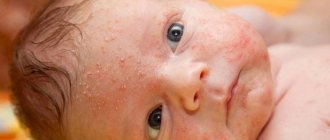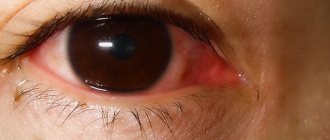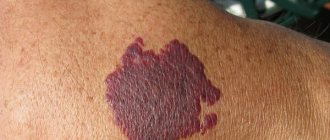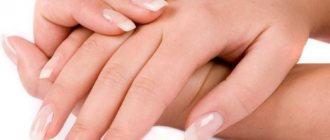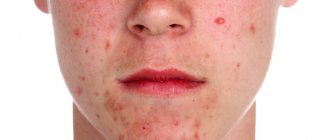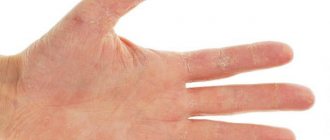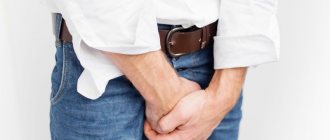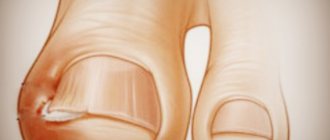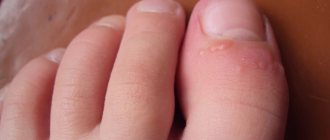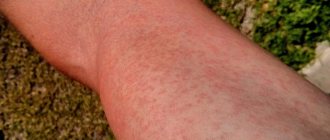The lower leg is an anatomical region that occupies the space from the knee to the heel joint. It, like other areas of the body, is a multi-layered formation: the skin is on top, a little subcutaneous tissue is under it, and muscles and bones are below, between which blood vessels and nerves pass. The peculiarity of pain in the lower leg area is that it can be caused not only by inflammatory, tumor diseases or impaired blood supply to any of the structures that make it up. It is this area that will hurt in response to severe intoxication (for example, with leptospirosis or influenza); It is here that it is most difficult for blood to rise through the veins against gravity, which creates the preconditions for the formation of varicose veins.
Let's look at why the lower legs hurt in relation to the location and nature of the pain syndrome, but first, let's briefly cover the anatomy, so that later it will be clear what is called what.
A little anatomy
The skin of the lower leg has nothing that distinguishes it from the skin of other areas. Its temperature, pain and tactile sensitivity is provided by nerves starting from the lower back and passing through the thigh.
The subcutaneous tissue of the lower leg is quite well defined. On the anterior surface it contains the saphenous veins - small and large, as well as the nerve going to the skin. Only their branches extend to the rear surface. Superficial veins communicate with deep veins lying between the muscle layers using special perforating (communicating) veins.
Under the fiber on the front surface there is fascia - a film covering the muscles, but here in its density it is more reminiscent of a tendon. Along the posterior surface, the fascia is not so dense, but is divided into 2 sheets, which divide the muscles into 2 layers - superficial and deep. Under the muscles there are 2 bones: the tibia - on the inside, the fibula - on the outside.
Calf muscles (crural muscles). They do not cover its entire anterior surface, leaving a “bare” section of the tibia along its outer surface (it can be easily felt). The muscles of the back of the lower leg form the so-called “second heart”. When walking, they push blood from the veins into the systemic circulation against gravity, and quite a large amount of blood can be deposited in these veins. Therefore, in situations involving blood loss or fluid loss, they try to raise the legs. When the bloodstream is overcrowded, which is accompanied by an increase in blood pressure, the legs are lowered, and even with thermal procedures they try to dilate the veins and remove a large amount of blood from them.
Bones. There are two of them: the wide and large tibia, as well as the small, cane-like fibula. There are sockets at the top and bottom of the tibia where the fibula is inserted. This connection is not very reliable, so the bones are additionally fixed with a membrane of dense connective tissue. Nerves and blood vessels pass through this membrane, piercing it through.
What can cause pain in the lower leg?
The lower leg may develop:
- inflammation;
- injury;
- tumor;
- circulatory disorders;
- damage to nerve fibers.
You may get sick:
- leather;
- muscles and their tendons;
- ligaments;
- bones;
- joints;
- nerves.
Let’s immediately make a reservation that the lower leg of the left leg has the same structures as the right one. Therefore, in further material we will consider pain depending on its location in the lower leg itself - both right and left.
My whole shin hurts
Pain syndrome of this localization is typical for:
- Fracture of the leg bones resulting from a blow, bruise, jump from a height or fall. At first, the pain may be localized, in the place where the blow occurred, but then the entire lower leg is captured. In addition, movements in the ankle joint become extremely difficult.
- Deforming osteitis, characterized by the predominance of bone destruction processes over its formation. The affected bone becomes deformed, which is accompanied by a dull, aching pain that almost never goes away and can intensify with rest.
- Impaired blood supply due to atherosclerosis or obliterating endarteritis, when the vessels feeding the tissues of the lower leg become increasingly narrowed, depriving them of nutrition.
- Gas gangrene, when the leg was wounded, and on the wounding object there was soil containing clostridia bacteria (this could be a nail, glass, and so on). Read gangrene of the lower extremities.
- Any of the tumors developing in the crural area, which has caused the blood vessels to be compressed or blocked by tumor cells. Thus, both benign neoplasms (osteoma, chondroma, lipoma, fibroma) and cancerous (they will be called sarcomas) tumors can compress the vessels. Only osteosarcoma, chondrosarcoma, leiosarcoma, melanoma, squamous cell skin cancer, rhabdosarcoma and others can clog blood vessels.
Why do my calves hurt: what to do for pain in the calf muscles
When the calves of the legs hurt after sports training or a long stay in an upright position, a person steadfastly endures unhealthy symptoms, explaining the phenomenon by the resulting overloads.
There is cause for concern if the pain does not go away for a long time, and the unpleasant discomfort in the calf muscles is complemented by cramps, aches, and tingling.
But even in this situation, “homo sapiens” is trying to independently figure out what caused the anomalous deviation and how to help himself. Let's explore how justified this behavior is.
Why do my calves hurt?
The main volume of the calves is provided by the triceps surae muscle. It unites the two heads (lateral, medial) of the gastrocnemius muscle and the soleus muscle underlying them. In the lower part of the leg, the anatomical structures are reunited to form the Achilles tendon. The blood supply to the calves is provided by the posterior tibial arteries and veins of the same name, and the innervation is provided by the branches of the tibial nerve.
Problems with any biological element will result in pain in the calves. The nature of the pain syndrome and accompanying symptoms will presumably indicate the culprit of the atypical sensations.
Varicose veins
Thinning and enlargement of the venous wall disrupts the functioning of the valves that allow blood to move upward to the heart.
Under the influence of muscle contractions, blood flow is directed downward, increasing pressure in the superficial vessels. In the initial stages, the disease manifests itself as spider veins and heaviness in the legs.
Gradually, nodular expansions are formed, visible to the eye. Pain is often felt in the calf muscles, which are cramped.
Deep vein thrombosis
Deformation of the venous walls, changes in blood flow and its rheological properties lead to the formation of thrombi - an accumulation of blood clots that block the lumen of blood vessels.
In the area of the affected vein, when walking and palpating, sharp pain occurs. The limb swells greatly. The color and temperature of the skin change.
The calves may become red, burning, or pale and cold to the touch.
According to statistics, in 80% of cases, varicose veins left unattended become a starting point for the development of thrombophlebitis and thrombosis.
Myositis
Inflammation of muscle tissue as a result of:
- introduction of viral, bacterial, fungal, parasitic infections;
- exposure to toxic substances;
- prolonged stay in an uncomfortable position;
- increased loads on the triceps surae muscle.
Typical symptoms are aching pain in the calves, aggravated by pressure, limited range of motion in the knee joint, and muscle weakness.
Polyneuropathy
A whole association of peripheral nerve diseases. The most famous representative is metabolic polyneuropathy, which develops against the background of diabetes mellitus or prediabetes.
The pathology is accompanied by a complex of motor and sensory disorders. Achilles tendon reflexes are lost, sensitivity to temperature changes, light touches, and vibrations is lost.
Sometimes a severe bursting pain suddenly strikes.
Polyneuropathy develops with a deficiency of B vitamins that nourish nerve fibers. In this condition, the skin on the calves becomes numb, tingling, muscle twitching, and weakness are felt. General health worsens, memory problems and mood swings are noted.
Tibial nerve neuropathy
The tibial nerve begins its journey from the popliteal fossa, encircling the triceps surae muscle with its branches. Its defeat, pinching, and inflammation affect the functional abilities and sensitivity of the lower leg.
Promote painful deviation:
- fractures;
- dislocations;
- sprained tendons and ligaments;
- pathological changes in the ankle or knee joint caused by gout, arthritis, arthrosis, vasculitis, tendovaginitis;
- bone growths;
- malignant formations.
Traumatic neuropathy is characterized by increased sensitivity, when the slightest touch causes discomfort. The calves of the legs ache, twist, the lower leg swells. If the nerve in the popliteal fossa is damaged, the calf muscles lose tactile and pain sensitivity.
Lumbosacral osteochondrosis
Degeneration and dystrophy of intervertebral discs, the elements of which extend beyond the vertebral bodies and compress the sciatic nerve. The transmission of information from the receptor endings of the tibial nerve to the spinal cord is distorted.
The disease manifests itself in the form of sharp painful shootings in the lumbar region, radiating along the surface of the thigh to the lower leg.
The so-called radicular syndrome is unilateral, so the calf of the left or right leg hurts.
Foot deformity
When the configuration of the arches of the feet changes, flat feet develop. The pathology progresses slowly. At first, your legs get tired and ache quickly after a long walk.
Corns appear on the soles, calluses often form, and the gait changes.
The more the foot flattens, the more pronounced the symptoms: the calves become heavy with lead, the intensity of the pain increases, the lower legs and feet swell. Over time, a varus or valgus deformity develops.
Other reasons
The following make adjustments to a person’s life activity and well-being:
- sedentary lifestyle;
- frequent stress;
- consumption of genetically modified products;
- obesity.
Hereditary predisposition has been and remains a harmful provocateur of pathological changes. If close relatives are plagued by pain in the calves, it is possible that they shared the problem at the genetic level.
Among women
For the weaker half of humanity, the risk factor increases due to:
- changes in hormonal levels;
- the use of contraceptives and drugs for the treatment of menopausal syndrome on a hormonal basis;
- wearing high-heeled shoes.
Women's calves often hurt during pregnancy. Several circumstances contribute to this. Starting from the very first weeks of pregnancy, the female body increases the production of progesterone. The sex hormone softens the ligamentous-muscular system, preparing the birth canal for the advancement of the child. The uterus, increasing in volume, infringes on the nerve fibers.
A growing belly shifts the center of gravity, redistributing the load. All nutrients received and accumulated by the biological system are used for the construction of vital cells in the fetus. In later stages, motor activity decreases. The amount of circulating fluid in the body increases.
Hence the pain, cramps, aches, heaviness in the legs, swelling.
In men
The cause of painful anomalies in men can be obliterating endarteritis. The disease primarily affects the small arteries of the legs. Among 100 patients with a confirmed diagnosis, 99 are male. Painful paroxysms are concentrated in the calf muscle of the leg, in the sole and fingers.
Signs of developing pathology:
- rapid fatigue and chilliness of the legs;
- spasms of muscle tissue;
- intermittent claudication;
- paresthesia;
- dry skin.
Unlike obliterating atherosclerosis, which is diagnosed in older and older people, endarteritis “prefers” younger people. Part of the male population from 20 to 40 years old is at risk.
Representatives of the stronger sex are not spared toxic polyneuropathies. The danger increases if a man likes to have a drink or two, indulge in psychotropic substances, or mercilessly smoke. In this case, nervousness, increased sweating, and erectile dysfunction are added to loss of sensitivity, cramps, and pain in the calves.
What to do
If your calves hurt, there is no need to tempt fate and wait for everything to “resolve” on its own. Timely seeking medical help will, at a minimum, help avoid the development of severe complications. In some cases, well-chosen treatment methods can not only stop the progress of the disease, but also reverse the pathological process.
Doctors recommend first of all to undergo adequate professional diagnostics:
- rheovasography of the lower extremities;
- duplex angioscanning;
- Doppler ultrasound of veins;
- electromyography;
- electroneurography;
- radiography of the lower leg;
- CT scan of the knee and ankle joint;
- general and biochemical blood test for the content of vitamins and minerals, the presence of heavy metals, sugar, cholesterol, glycated hemoglobin, for the determination of rheumatoid factor and antibodies.
According to indications, a test for tumor markers is carried out, cells or tissues are collected for biopsy.
There is no standard examination for pain in the calves. An experienced specialist prescribes diagnostic procedures based on the patient’s complaints and family history.
Carefully collected anamnestic information allows you to avoid misdiagnosis and accurately determine the cause of painful paroxysms.
Treatment
The doctor determines how to treat the diagnosed pathology and in what mode, taking into account the severity of the changes that have occurred in the body, the patient’s age, and the risk of adverse reactions. The main tactics of treatment is to eliminate the root cause of the disease. The pain will go away if the harmful source is neutralized.
The following is used as symptomatic therapy:
- non-steroidal anti-inflammatory drugs;
- analgesics;
- external venotonic agents;
- warming ointments;
- massotherapy;
- physiotherapy;
- relaxing foot baths.
For varicose veins, experts prescribe wearing compression stockings.
Conclusion
In order not to have to “live on pills” or resort to radical measures – surgical intervention, you need to constantly keep yourself “in check”:
- reduce the consumption of salty, spicy, fatty foods as much as possible;
- diversify your diet with foods rich in fiber, vitamins, and microelements;
- replace 2-3 meals a day with fractional (5-6 times) meals;
- do not forget about daily dosed exercises.
Daily self-control will not be a heavy burden when it becomes a habit.
If you want to relax, it is better to lie down with your feet on any convenient elevation than to sit. When working sedentarily, it would be better to walk around than just stand.
For people whose relatives suffer from leg pain, doctors strongly advise not to neglect an annual preventive examination.
Source: https://proartrit.ru/bolyat-ikryi-nog/
Pain on the front of the shin
When the tissues of the lower leg hurt in the front, this can happen due to the following reasons.
Injuries
A blow to the front, a fall on the knee while skateboarding, roller skating or cycling, which did not provoke a fracture, but only damage to the soft tissues, will be accompanied by pain in the lower leg in the front.
It could also be a sprain or rupture of a ligament that occurs due to injury or intense training.
If there is a fracture, the whole leg will hurt.
Burns
The front surface of the leg can be burned when cooking - with boiling water or boiling oil. A red hot spot or even a watery blister will appear in this area
Inflammation
Erysipelas can often occur in the anterior part. This is a red or pink spot of not very small diameter, looking like a painted flame.
Inflammation can be caused not only by streptococcus, as with erysipelas. Other microbes can also provoke an inflammatory process in local soft tissues. They can get there when injured by infected material, when there is poor blood supply, when trophic ulcers occur.
Pain in the back of the shin
Pain on the back of the lower leg is characteristic of the following diseases and conditions:
Injuries
If the blow or fall occurred on the back and did not cause a fracture, the soft tissues in the damaged area will hurt.
Periostitis
If it hurts from the back and side (along the inner surface), it may be periostitis - inflammation of the periosteum. Its causes: prolonged physical activity in untrained people, bruises, fractures. Such pain most often develops in the lower leg of the right leg, which is usually the “pushing” leg and receives a greater load. They appear a short time after training or exercise. There may be a slight swelling at the site of the lesion, which, if touched, will be painful or unpleasant. The skin is not red or swollen.
Inflammatory processes
Exactly the same processes that are described for the anterior surface can develop and cause pain in this location.
Deep posterior tunnel syndrome
If the muscles underlying the triceps surae become infected, lose their normal blood supply, or become stretched, they become sore because they are encased in fascia and unable to expand.
Pain along the posterior crural surface. It is sharp, bursting. It intensifies when trying to straighten the leg. If the pathology is not treated, swelling will appear in the affected area, the skin will turn red or bluish, and the temperature will rise above it. Later, sensitivity is impaired, and the muscles begin to work worse.
Calf muscle strain
If you jump unsuccessfully or try to run too fast, a calf muscle strain may occur. This is manifested by sharp pain in the posterior crural regions at the time of stretching. Over time, the tissues swell and the pain intensifies.
Inflammation of the Achilles tendon
Strenuous physical activity can lead to inflammation of the tendon that attaches to the heel bone. In this case, aching pain appears in the lower parts of the back of the leg. It intensifies if you need to bend the foot, for example, when walking or running.
Myositis of one of the muscles of the posterior group
The muscle begins to ache, and this pain intensifies when the foot is extended, the muscle is compressed, or when the weather changes.
Baker's cyst rupture
Some people may have a connective tissue capsule filled with fluid called a Baker's cyst in the dimple on the back of the knee joint. If it ruptures and fluid enters the intermuscular spaces, this is manifested by pain, soreness, and increased local temperature.
Why is the calf of the leg swollen and painful?
The gastrocnemius is a biceps muscle located at the back of the human lower leg. The calf is responsible for the stability of the body during movement and for the motor function of the foot. Pain in the calf muscle is a common occurrence in the adult population. Often, along with pain, the calf becomes swollen (edema). Often pain and swelling affect both calves at the same time.
Most suffering people do not attach importance to swelling and swelling of the legs, blaming the process on fatigue or a temporary excess of water in the body.
The calf can get sick suddenly, as a result of the slightest discomfort, then quickly go away. But the phenomenon is a consequence of a serious illness.
If the calf of the leg is swollen or pain appears, you need to seek the help of a doctor to identify the cause of the symptoms and prescribe subsequent measures for recovery.
Causes of pain and swelling in the calves:
- Dangerous heart or blood vessel diseases;
- Serious liver and kidney diseases;
- Diseases of the venous vessels;
- Pathology of arterial vessels;
- Diseases of the calf muscles;
- Damage to the nerve trunks approaching the lower extremities;
- Diseases of surrounding tissues;
- Spine pathology.
Other factors are known that influence the appearance of swelling in the calf of the leg:
- abuse of drugs, diuretics and laxatives;
- taking contraceptive or hormonal medications;
- pregnancy, premenstrual syndrome;
- improper, unbalanced nutrition with excessive carbohydrates and salts;
- slow elimination of salts by the body;
- allergic reactions;
- leg injury.
Diseases that include pain and swelling in the calves
Many diseases have been described that are accompanied by pain and swelling of the calf muscle:
- Acute leg artery occlusion;
- Inflammation of skeletal muscles - myositis;
- Neuritis (osteochondrosis) and polyneuritis (diabetes, chronic alcohol poisoning, dystrophic pathologies, infectious diseases);
- Osteomyelitis;
- Pathology of the leg joints;
- Damage associated with ruptures or tears of the Achilles tendon;
- Inflammatory processes on the skin, in the subcutaneous tissue of the lower leg;
- Inflammation of the sciatic nerve on the right, left side, other diseases of the spine.
Let's name common cases of swollen calves with pain.
Phlebeurysm
The disease affects predominantly the female half of the population (it also happens in men) after 20 years of age, and is often hereditary in nature. The reasons for the occurrence are different: prolonged stress on the legs, wearing shoes with heels higher than 5 cm, pregnancy, injuries, smoking and others. As the disease progresses, the superficial veins are affected, which is noticeable visually.
In the aggravated stage, a feeling of heaviness in the legs, frequent fatigue, cramps (usually at night), and pain appear. At times, the affected area of the calf becomes swollen, dermatitis can develop, and long-lasting trophic ulcers occur.
Varicose veins do not always affect both legs equally; sometimes the disease is more pronounced on the right or left leg.
If the preconditions for varicose veins appear on one limb, it is worth taking enhanced measures to prevent the appearance of varicose veins on the second leg.
Prevention of varicose veins
In addition to these general recommendations, for varicose veins it is necessary to follow simple rules, the implementation of which will help slow down the development of the pathology or help avoid its occurrence:
- Do not get carried away with taking hot baths;
- Lose weight (subject to extra pounds);
- Do not wear excessively tight clothes or clothes that compress blood vessels (for example, jeans that are too tight);
- Alternate loads;
- Introduce fiber-enriched foods into your diet;
- Rinse your feet with cool water at the end of the day;
- Try to walk more often in the dew or along the water’s edge;
- Do special exercises for your legs.
Thrombophlebitis (thrombosis)
A common vascular disease in which the calf muscle pulsates and the sensation gradually turns into a burning sensation. The pain is constant.
With thrombosis, the calves of the legs swell, heaviness appears, the skin at the site of the lesion takes on a smooth, shiny appearance, and veins become visible. The pain is distributed along the back of the lower leg from the foot to the thigh, and increases with flexion.
Similar to varicose veins, thrombosis can develop in the right, left leg, or both.
Thrombophlebitis is dangerous. Blood clots or their particles that form in blood vessels can travel along with the blood, causing blockage of the vessel and possibly death. If you notice signs that are similar in symptoms to thrombosis, you should immediately consult a doctor.
Prevention of thrombophlebitis
- Drink water in the amount required by the body; water effectively prevents the formation of blood clots.
- Introduce foods that have blood thinning properties into your diet:
- ginger;
- sunflower seeds;
- beet;
- fish fat;
- linseed, olive oil;
- tomatoes and tomato juice;
- rolled oats porridge;
- lemon;
- garlic and onion;
- cherries, sweet cherries, cranberries, raspberries, wild strawberries, strawberries.
It is recommended to eat these products constantly, at least 2-3 units from the listed ones.
- Reduce your intake of foods that affect blood clotting:
- broths prepared with meat;
- sausages, smoked meats, jelly;
- products made from wheat flour;
- heavy cream;
- lentils, peas;
- rosehip, chokeberry;
- mango, bananas;
- Herbal decoctions that reduce bleeding and blood fluid.
- Stop drinking alcohol and smoking.
- Reduce the amount of salt;
- Try to avoid the use of diuretics, contraceptives, hormonal drugs, and supplements aimed at increasing libido.
- Lead an active lifestyle, go out into nature more often, breathe clean air, and play sports.
General measures for the prevention and relief of pain due to swelling (edema) of the calves of the legs
Reducing calf swelling is the most important goal for calf swelling. Elevating your legs will help. It is recommended to place the feet on an elevation, at a level higher than the level of the heart, so that the load and pressure on the lower body is minimized. It is permissible to use special devices.
When sleeping, place your feet on pillows to ensure an elevated state.
To prevent edema, use special tights, socks, stockings, which can be easily purchased at a pharmacy or specialized orthopedic stores.
It is important to wear the correct shoes that fit in size: they should not squeeze or put pressure on the heel or toe. To choose a comfortable size, it is recommended to purchase shoes in the afternoon, when your feet are already tired and slightly swollen.
To reduce swelling in your calf(s), it is recommended to follow these tips:
- increase the load on the leg muscles by walking;
- avoid a static state, stand less;
- do not sit in a cross-legged position without squeezing the veins in the back of the leg;
- reduce salt intake, prevents water from leaving the body;
- do not use excessive amounts of medicinal, diuretic, laxative, hormonal and contraceptive drugs;
- drink more plain clean water (the average person’s water consumption is 2 liters per day).
An alarming sign is that the swelling of the legs does not disappear with the use of preventive measures. Then you should consult a doctor.
These measures are advisory in nature.
Treatment of pain and swelling of the calf muscles of the legs
Most diseases of the calf muscle can be easily eliminated with treatment at home or in a hospital setting. However, there are diseases, for example, acute vascular pathologies, myositis, complicated chronic vascular insufficiency, and certain pathologies of the spine, which require the intervention of a surgeon or constant medical supervision.
It happens that complete relief from pain and swelling of the legs is impossible. Then traditional methods of treatment (injections, tablets, heating) are used to maintain and weaken the symptoms of the underlying disease. For example, for diabetes - insulin, for varicose veins - special elastic tights or stockings.
Of course, you need to understand an important thing - under no circumstances try to solve a leg problem on your own. Only a doctor can correctly determine the causes of pain and swelling in the legs through examination and testing.
Following prevention recommendations in order to reduce the risk of disease is valuable and correct.
It is also necessary to carry out certain measures to reduce pain - do exercises and massages, use special devices, but only after establishing a specific diagnosis and consulting a doctor.
Source: https://OtNogi.ru/simptomy/opuhol/pochemu-opuxla-ikra-nogi-i-bolit.html
Shin bones hurt
When pain is noted in the bones of the lower leg, this may indicate:
- periostitis. The pain syndrome is caused by heavy load on the legs, especially often observed among soldiers in the first month of service or those who decided to quickly “pump up” their legs. Above the inflamed periosteum there is a slight swelling of the skin of unchanged color, the bone in this place is painful. Nothing is visible on the X-ray for the first 20 days;
- Osgood-Schlatter disease;
- Osteitis deformans. This process is characterized by a disruption of the normal processes occurring in the bones of the leg. Instead of the process of bone renewal (its destruction and creation) occurring gradually and in a balanced manner, destruction begins to predominate. Bones try to repair themselves, but they do so more slowly, so they tend to break;
- osteomyelitis - inflammation of the bone marrow located in the tibia. The pain is bursting, severe, accompanied by fever, drowsiness, weakness, and sometimes nausea. Read more about the symptoms of osteomyelitis.
Muscle pain
If the pain is in the lower leg muscles, it may be:
- myositis;
- muscle soreness that occurs due to overload of muscle tissue during training or work. The pain can be quite severe; it goes away after a short period of inactivity;
- varicose veins, when dilated veins are visible on the back of the leg;
- leptospirosis. This disease most often occurs in hunters and fishermen, and is characterized by a severe course with damage to the liver and kidneys. Both legs hurt, this is also accompanied by weakness and fever. Over time, a person may notice a yellowing of his own skin, and then a decrease in the amount of urine;
- pain in the calf muscle can be observed after its cramp, which occurs against the background of dehydration, during pregnancy, when in cold water;
- disruption of innervation that occurs with osteochondrosis or intervertebral hernia localized in the lumbar spine;
- tunnel syndrome - anterior, posterior or lateral.
Skin pain
Pain in the skin of the lower leg is observed with:
- Trauma (bruise, compression, crushing) of tissues. In this case, there will be a bruise or bruise on the skin; the person must also remember the fact of the injury.
- Burn: solar, chemical or physical. The skin is red, swollen, and may have blisters. A person can indicate the fact of a burn.
- Inflammation (for example, erysipelas or herpes). This inflammation is a noticeable phenomenon. Thus, the erysipelas process looks like a bright pink spot on the skin, hot to the touch, with clear, flame-like boundaries. Herpes zoster is a group of blisters located along the nerve trunk, the skin under which hurts.
- Cellulitis, that is, the melting of subcutaneous tissue caused by pyogenic bacteria. It occurs after a penetrating wound or against the background of trophic ulcers, when staphylococci, streptococci, Pseudomonas aeruginosa and other bacteria get under the skin.
Mechanical causes of redness and itching on the legs
Skin irritation due to friction and accidental scratching does not require close attention and medical correction. Let's figure out what can be annoying:
- Synthetic clothing. For example, these could be tight trousers or tights. They sometimes contain fibers that prevent air circulation.
- Insect bites. When contacting mosquitoes, flies, or bees, foreign proteins are injected into the skin. After this, redness and itching may occur on the skin of the leg.
- Tight, hard shoes. In this case, the irritation will be localized on the foot, in those places where intense friction occurs.
- Depilation. After the procedure, if skin soothing agents are not applied in time, you can often detect hyperemia due to microdamages.
Approximate diagnosis based on the nature of pain
The shin hurts a lot when:
- Osgood-Schlatter disease;
- phlegmon;
- gas gangrene associated with the entry into the wound on the leg of soil, dust (by themselves or with a wounding object), which contains clostridia - anaerobic bacteria;
- tumors developing from the bones of this anatomical zone. The pain is sharp, stabbing, worsens with physical activity;
- tunnel syndromes.
Sharp pain is characteristic of osteomyelitis - purulent inflammation of the bones that contain red bone marrow. The pain is bursting, constant, exhausting. It is accompanied by deterioration of the condition (weakness, drowsiness, loss of appetite), increased temperature. It becomes painful to walk, and when you tap on the affected bone, the pain intensifies.
If the pain is aching , this may indicate:
- tendonitis (inflammation of the tendons of the lower leg). It often develops when tendons are injured, frequent or intense physical activity, when a tear occurs at the site of attachment to the bone. The pain is localized in the area of the tear, the skin in this area swells, may turn slightly red, and shows increased tactile and pain sensitivity;
- intervertebral disc herniation;
- Osteitis deformans.
Associated signs of skin moodiness
On the legs, red skin often parallels a feeling of severe itching in the area. At the same time, the epidermis begins to peel off. Itching in the legs can develop as a result of an allergy to any irritant, a fungal skin disease or dermatitis of an allergic, chemical, contact or idiopathic nature.
In some cases, along with hyperemia and swelling, pinpoint rashes may appear on the legs. This symptom also often speaks in favor of the allergic nature of the process.
In case of traumatic injury to the legs, hyperemia and swelling may be accompanied by painful sensations of varying severity.
What additional symptoms may indicate?
Pain in the lower leg when running is a symptom that indicates a violation of the blood supply to the tissues. This is typical for two diseases: obliterating (that is, narrowing the lumen of blood vessels) atherosclerosis and obliterating endarteritis. In the initial stages of the disease, the entire lower leg will hurt only with prolonged walking or significant physical activity. When pain in the lower leg occurs when walking or even at rest, this means that the disease has gone far, and without taking appropriate measures, tissue death (gangrene) may occur.
A similar symptom can also be observed with tumors, when the newly formed tissue has compressed the vessels that feed all other tissues. It does not have to be a malignant tumor; a lipoma or chondroma may also well cause this clinical picture.
Also, pain when walking will occur when:
- muscle strains. This occurs a little after an injury, accident or awkward movement;
- fractures or microcracks of bones. This condition is also provoked by trauma, in contrast to arterial diseases that arise “out of nowhere”;
- varicose veins of the leg.
If your leg is swollen, it may be:
- Periostitis. In this case, the swelling is small, but it is painful to touch. Skin color is not changed. Pain occurs 2-3 days after an exhausting workout, bruise or fracture.
- Osteomyelitis. It is characterized by fever, redness and swelling in the local area, pain when walking.
- Phlegmon. The temperature rises, appetite decreases, and you may feel sick. Swelling and tenderness in the crural area spread over a large area.
- Gas gangrene. There is always a wound, in which bacteria that cannot tolerate oxygen are introduced under the skin.
- Swelling and a change in the color of the leg to bluish indicate that a large vein is blocked by a blood clot. This requires urgent surgical intervention.
- Slight swelling without a change in skin color may indicate the development of venous insufficiency due to varicose veins.
- Tunnel syndrome.
Finding out the cause of a citizen’s skin problems
Redness and itching on the legs are often one of the manifestations of allergies. In most cases, this symptom is characteristic of an allergic reaction in children, but it can also occur in adults.
Provoking factors in this situation will be:
- insect bites;
- presence of helminthic infestations;
- photoreaction or skin reaction to the sun;
- some medications (antibacterial drugs, analgesics, etc.);
- hypersensitivity of the body to cosmetics, the material from which clothing is made, or to food.
If the allergy is not confirmed, the person may think there are other factors. There are no effects on the condition of the legs.
The photo shows redness on the legs for no apparent reason:
But various factors can cause this condition:
- excess body weight;
- hypovitaminosis and vitamin deficiency;
- diseases related to the thyroid gland;
- prolonged exposure to stress factors;
- Varicose veins;
- unadapted excessive power loads;
- disorders of the urinary system;
- diseases affecting the cardiovascular system;
- excessive levels of the female hormone estrogen in the body;
- the presence of somatic diseases of a neurological nature (a history of stroke can lead to hyperemia and edema);
- problems associated with the circulation of lymphatic fluid in the extremities;
- skin lesions due to eczema, dermatitis or trophic ulcers;
- work in hazardous industries (chemical industry, sudden temperature changes);
- leg joint injury, ligament sprain, muscle damage;
- unbalanced diet (excessive amounts of salty and spicy foods in the diet can lead to redness and swelling of the lower extremities);
- presence of bad habits (nicotine addiction, excessive consumption of alcoholic beverages);
- low level of physical activity, sedentary lifestyle, or vice versa, wearing uncomfortable shoes or excessively high heels.
If your child's shin hurts
Pain in the lower leg in a child may occur due to the following:
- fracture, bruise or prolonged compression of the tissues of the crural area;
- muscle cramps when in cold water or developed during diarrhea, when dehydration occurs and the body is deprived of calcium or magnesium, other conditions accompanied by a decrease in the blood concentration of calcium/magnesium;
- osteomyelitis;
- periostitis;
- Schlatter's disease;
- gas gangrene.
Tumors develop extremely rarely in childhood, but if the above reasons are excluded, it is necessary to be examined for oncological pathologies, including.
Actions for crural pain
What to do with such a symptom before consulting a doctor depends on the cause of the disease:
- If you had an injury or intense training the day before, you can take a painkiller: Nimid, Ibuprofen or Dexalgin. The limbs need to be kept at rest and the muscles should be bandaged with an elastic bandage. To reduce pain, you can apply ice wrapped in a dry diaper to the sore spot for 15-20 minutes 3-4 times a day. Impaired movement in the leg, increased swelling after injury is a reason to consult a traumatologist.
- If the pain appears spontaneously, despite the fact that the person does not have varicose veins, this is also a reason to visit a traumatologist.
- Pain syndrome, fever and deterioration in general condition indicate the need to visit a traumatologist (if bones hurt) or an infectious disease specialist (when muscles hurt). You need to call an ambulance and go to an infectious diseases hospital or any other hospital if, in addition to crural pain syndrome, you have one of the following symptoms:
- decreased amount of urine;
- yellowing of the skin;
- high temperature, especially when it does not decrease well when taking antipyretic drugs;
- feeling of “lack of air”;
- dyspnea;
- pain in the right hypochondrium.
- When you notice that it’s painful to walk, but only your lower leg hurts and not your back, you need to perform Doppler ultrasound (triplex or duplex scanning) of the arteries of the lower extremities, and then visit a vascular surgeon.
- When your shin bothers you due to frequent muscle cramps, donate blood to check for calcium and magnesium levels, consult your family doctor, therapist or pediatrician.
- Swelling, bursting pain, crunching tissue in the place where there was injury several times, indicate the likely development of gas gangrene, which is life-threatening. It is treated only in a surgical hospital through surgery and constant washing of the wound with hydrogen peroxide, potassium permanganate and other solutions that bring oxygen to the tissues, which is harmful to clostridia.
Which doctor should I contact?
If a spot appears on your leg, you should immediately consult a doctor. The doctor will help you figure out why it formed and what to do about it. A dermatologist deals with changes in the skin. The specialist analyzes the patient’s complaints and examines the affected areas. If necessary, prescribe examination by other highly specialized doctors:
If red spots appear on your legs, consult a dermatologist
Consultation with several specialists allows you to accurately determine the cause of the appearance of red spots and select effective therapy.
